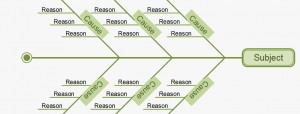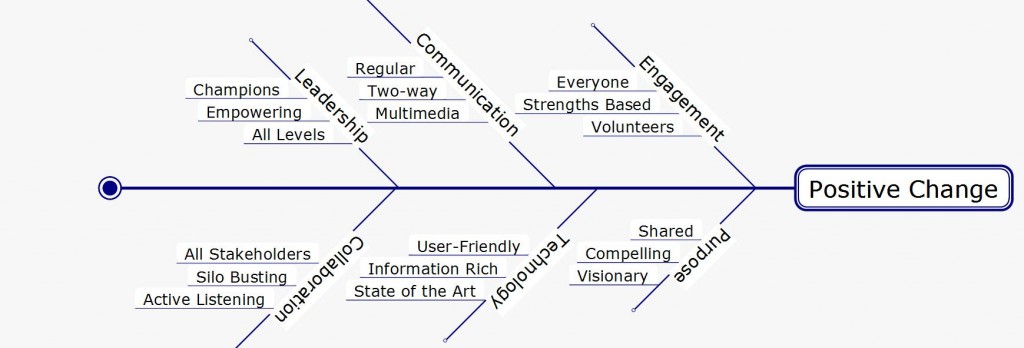One of the Lean tools that is used to determine the root cause of a problem is the Fishbone Diagram, also known as the Cause and Effect Diagram or Ishikawa Diagram. It identifies and explores on a single chart the 5 – Why technique, The aim is to work down through the causes to identify basic root causes of a problem by asking the question why, 5 times.
It appears very simple but the results are outstanding. As a result, it is used very often and one that should be mastered. Why would you use it?
- Allows various categories of causes to be explored.
- Encourages creativity through a brainstorming process.
- Provides a visual image of the problem and potential categories of causes
- Analyze Complex problems that seem to have many interrelated causes
The basic layout for manufacturing consists of six categories: Materials, Machine, Measurement, Methods, Manpower and Milieu (Environment). The basic layout for administrative processes consists of four categories: Personnel, Plant Facilities, Policies and Procedures.
Depending on the situation, other categories are possible. The application is very similar in each:
- Select the Problem Statement, or Effect, shortened into a few key words and place it in a box on the right side of the new diagram.
- Use the categories above or create your own depending on the situation and connect them with a straight line to the “backbone” of the diagram.
- Brainstorm or determine data-driven causes for each category.
- Continue driving down, identifying further lower-level Root Causes.
This classic method is a powerful tool in problem solving methodology. However, can it be equally powerful for creating an analysis of strengths or successes. In the book, Appreciative Leadership , the authors use the Fishbone diagram, depicted below to illustrate the positive core or a group or team.
The authors discuss this approach:
Not only does a root-cause-of-success analysis give you information about your team and your organization at its best; it also shines the light on daily acts of excellence that all too often go unrecognized. It gives credit to high performers and sets the expectation that every-
one else should follow their lead. By illuminating the best of people, processes, teams, Appreciative Leadership signals to others, “do it this way and we will all benefit.”These institutional habits are as hard or harder to change than personal habits. One way to change the “squeaky wheel gets the attention syndrome” is with a root-cause-of-success analysis. By inviting team members or a cross-functional group of people to identify and discuss what causes their success when they are at their best, you send a clear message that what you value and want to understand is success.
The field of Appreciative Inquiry inspires me, finding it quite intriguing. After decades of problem solving, it is not an easy journey to create an appreciative look at business. It is just not a natural instinct for any of us. Using a Positive Fishbone can provide a good visual indicator for teams and leadership.
The authors also gave us 5 core strategies for successful Appreciative Leadership that I found equally enlightening.
- Inquiry lets people know that you value them and their contributions.
- Illumination helps people understand how they can best contribute.
- Inclusion gives people a sense of belonging.
- Inspiration provides people with a sense of direction.
- Integrity lets people know that they are expected to give their best
for the greater good and that they can trust others to do the same.
Accentuate the Positive, Eliminate the Negative is a recent podcast on the subject. Sounds like a good song doesn’t it? My favorite rendition of the song is a Bette Midler & Bing Crosby rendition.
Related Information:
Appreciative Inquiry instead of Problem Solving
My Engagement Strategy – Appreciative Inquiry
Mastering Positive Change


